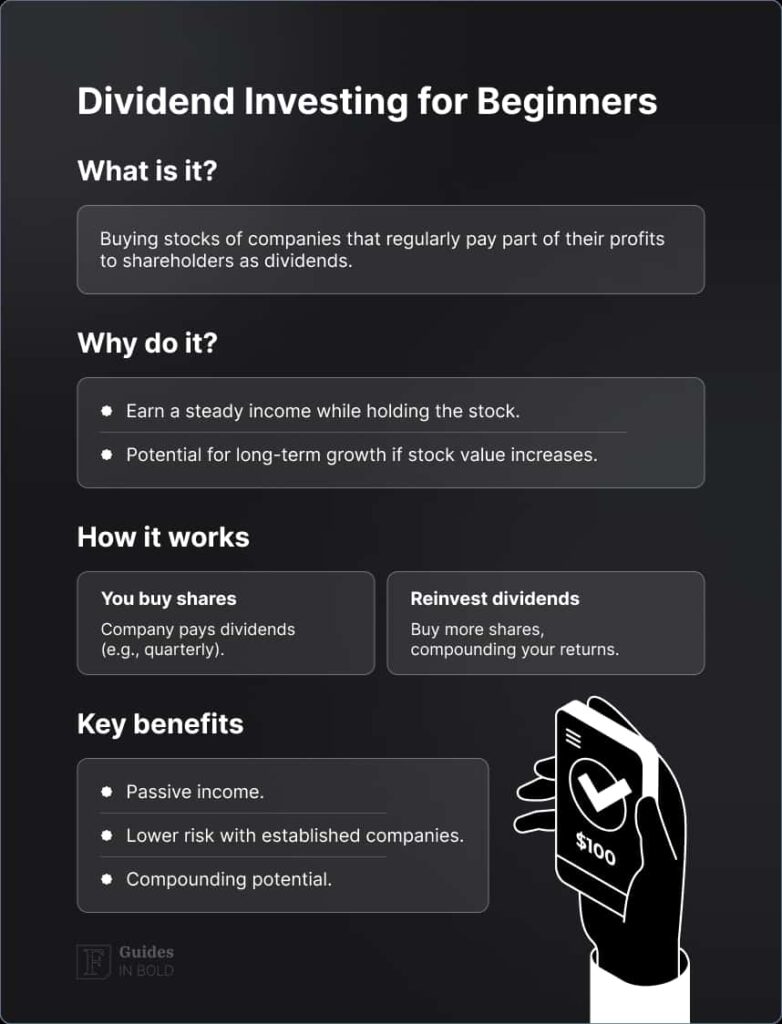In this guide, we’ll discuss what are dividends and the many sorts of payouts that are available. As part of this discussion, we’ll go through the dividend dates that investors should be aware of and how to evaluate a company’s dividend payout. Finally, we’ll take a look at the many sorts of companies that pay a dividend.
About dividends
Dividends are the distribution of part of a company’s profits to shareholders. It is most commonly paid in cash and goes directly into a shareholder’s brokerage account. Dividends are paid per share and have to be approved by a company’s board of directors and its shareholders with voting rights.
If an enterprise is successful at selling its products or services and keeps costs under control, it makes a profit. Companies generally have three options for what to do with their earnings. They can choose to:
- Reinvest it in the business;
- Hold on to the earnings for future needs;
- Distribute part of the profits to shareholders.
The last option is called a dividend and most often comes in the form of cash, but other dividend types exist as well. Further on in this guide, we’ll discuss different types of dividends – stock, special, preferred, coupled with dividend reinvestment programs.
A shareholder of a dividend-paying company receives a dividend per share. For example, if an investor has 50 shares of Apple and the company pays $1 in cash dividends per year, the investor receives $50. The money goes straight into the investor’s brokerage account.
The dividend has to be approved by a company’s board of directors and the board also decides on the amount, frequency and date of the dividend. Additionally, shareholders have to approve the dividend with their voting rights.
Whereas most dividend-paying companies in the U.S. pay dividends quarterly, European companies tend to pay dividends either annually or semiannually. Furthermore, some companies pay monthly dividends, such as Real Estate Investment Trusts (REITs).
The image below depicts two options for how a company can use its net profit:

Different types
Cash dividends are by far the most common type of dividends. However, there are other sorts of dividends a company can choose from. These include:
- Stock Dividend: Companies can choose to give shareholders additional shares instead of cash. For investors who depend on the dividend income, this might be less appealing as they will first have to sell shares before they have the money at their disposal;
- Property Dividend: Instead of cash or stock, a company can choose to pay shareholders a dividend in the form of physical assets. An example of this could be real estate owned by the company. A subsidiary’s shares also fall into this category;
- Scrip Dividend: In the case that a company doesn’t have enough money to pay dividends, it can choose to issue a scrip dividend. This type of dividend is similar to a promissory note as it entitles shareholders to a payment in the future;
- Liquidating Dividend: When a company liquidates, it can choose to return capital to shareholders in the form of a liquidating dividend. What sets this type of dividend apart is that it comes from a company’s capital base, while dividends normally come from a company’s operating profits or earnings;
- Preferred Dividend: This type of dividends is only paid to holders of preferred stock. This type of stock is comparable to bonds and generally pays dividends on a fixed schedule.
In addition, companies can also issue special one-off dividends. The company American Financial Group (AFG), for example, has paid 15 special dividends in 10 years in addition to its regular dividend payments.
Furthermore, some brokers, such as Robinhood, offer a Dividend Reinvestment Program (DRIP). A Drip lets investors reinvest dividends they have received back into the company automatically.
Watch the video: Dividend Reinvestment Plans
Dividend dates
To understand when a dividend is paid and how that decision is made, we need to look at a few important dividend dates. The most important dates to consider are as follows:
- The announcement/declaration date: A dividend payment is formally announced by a company’s board of directors on this day, usually through a press release;
- Ex-dividend date: The most important date for investors who wish to receive a company’s dividend. You need to own the stock by this date to receive the declared dividend. If you buy the stock on or after this date, you are not eligible to receive the dividend;
- Record date: This can be viewed as the cutoff date. On the record date, the company determines which shareholders have registered ownership of shares and will therefore receive the dividend. In most countries, having the shares in your possession before the ex-dividend date is enough to be registered;
- Payment date: On this day, a company pays shareholders the dividend. It can sometimes take a couple of days to show up in a brokerage account.
In the image below we can see the dividend process step-by-step:

How to evaluate a dividend
To determine whether a company’s dividend is sustainable and competitive, we can use a couple of different ratios. The ratios can help you compare a stock’s dividend to those of competitors and evaluate how safe a firm’s dividend is.
These are the three most common ratios for evaluating a company’s dividend payout:
#1 Dividend yield
The dividend yield is the most popular ratio for evaluating a stock’s dividend. We can calculate a stock’s dividend yield by taking the dividend paid per share annually and dividing that number by the current share price.
For example, if company A has a share price of $200 and pays an annual dividend of $10 per share, the dividend yield would be 5%. As we stated in our guide on dividend investing, a dividend yield between 2% and 6% is considered good.

When the share price increases, a company’s dividend yield decreases, and vice versa. That explains why companies that have been performing badly can have a high dividend yield. Therefore, it’s not always a good sign when a stock dividend yield is very high.
A good example of this is the company Royal Dutch Shell (RDSA). The company had a whopping 10.67% yield on the 14th of May 2020 after the stock had plummeted due to a market crash. This high yield turned out to be a great indicator of an unsustainable dividend as Shell announced drastic cuts to its dividend.
Royal Dutch Shell’s high dividend yield and subsequent cut are depicted in the image below:

#2 Payout ratio
The payout ratio is one of the best ways to evaluate a dividend’s sustainability. The payout ratio shows us the percentage of a company’s net income that is used for dividend payments. You can calculate the payout ratio by dividing a company’s dividends by its net income.
A good rule of thumb is to avoid companies with a payout ratio of 80%. A payout ratio of higher than 100% means that a company spends more on dividends than it receives in earnings.
This is considered to be a red flag as it could indicate the possibility of dividend cuts in the future, especially during tough economic times when a company might not have sufficient funds to pay the dividend.
In the image below we can see an example of a hypothetical company’s payout ratio:

#3 Dividend per share
Another popular way to evaluate a company’s dividend is by looking at its dividend per share (DPS). The dividend per share can be calculated by taking the total amount of dividends paid by a company and dividing it by the total number of shares outstanding.
Alternatively, the DPS can be calculated by taking the company’s earnings per share and multiplying it by the dividend payout ratio. Either way, this way investors can get insight into the dollar amount per share.
Using the DPS, we can see how much is distributed by a company in dividends per share in a given period of time, allowing us to judge a company’s ability to grow its dividends over time.
An example of dividends per share calculation is depicted below:

Information on a company’s dividend yield, payout ratio, and dividend per share can be found on financial websites and are normally listed on online broker websites as well.
Which companies pay dividends?
Dividend-paying companies are usually large, well-established companies with consistent cash flows, most of those being blue-chip stocks. In 2015, almost 84% of companies in the large-cap index S&P 500 paid dividends, according to the Financial Industry Regulatory Authority (FINRA).
The same research shows us that this number is only 70.5% for the S&P mid-cap index and just 54% for the S&P small-cap index. The reason behind this is that companies with a smaller market cap are often growing fast and need to invest the money back into the company.
There are a couple of reasons to why a company decides to pay a dividend:
- A dividend rewards loyal shareholders for holding on to the stock;
- Paying a dividend signals a company’s confidence in the future;
- A robust dividend track record benefits a company’s reputation.
Another reason might be that a company can’t find any suitable projects to invest in. This can be viewed as a negative as it might indicate slowing growth in the future.
Where to find dividend-paying stocks?
Most dividend-paying companies are easy to find as they are usually active in one of the following sectors:
- The industrial sector;
- The consumer staple sector;
- The materials sector;
- The financial sector;
- The healthcare sector.
Companies in these sectors normally have very dependable revenue streams, allowing them to pay and increase dividends over a long period of time. Many of these are included in the S&P 500 Dividend Aristocrats, an index composed of companies that have increased their dividend for 25 years in a row.
A few examples of well-known dividend-paying companies are:
In the image below we can see a sector breakdown of the S&P 500 Dividend Aristocrats:

An important side note here is that aside from individual stocks, ETFs and mutual funds can also pay dividends. These funds normally receive dividends from dividend-paying stocks in their portfolios and subsequently distribute these dividends to fundholders.
Conclusion
Dividends are an attractive proposition for investors who are looking for an additional way of making money with stocks. However, to invest in dividend-paying stocks successfully, it is essential to understand what dividends are and what type of dividend a company pays.
Furthermore, an investor has to be aware of all the relevant dates related to a dividend payment. If you purchase shares after the ex-dividend date, for example, you won’t be eligible for the next dividend.
Additionally, it’s important to evaluate the safety of a company’s dividend by using the right ratios. A high dividend yield might look attractive but sometimes has a dubious reason. There are many examples of firms with spectacularly high dividend yields that had to drastically cut their dividends.
Lastly, an investor has to know where to look for the best dividend stocks. Luckily, this is made easy by the fact that most dividend-payers are large, well-established companies and are usually included in the major market indexes.
Disclaimer: The content on this site should not be considered investment advice. Investing is speculative. When investing, your capital is at risk.
FAQs about dividends
What is a dividend?
A dividend is a distribution of a company’s profits to shareholders, typically in cash directly deposited into their brokerage accounts. Approved by the board of directors and shareholders with voting rights, dividends are paid per share. Another type is a stock dividend, where investors receive additional shares instead of cash. Some investors adopt a dividend investing strategy, concentrating on stocks that offer regular dividends.
Where can I find dividend-paying stocks?
Dividend-paying stocks are commonly found in sectors such as industry, consumer staples, materials, finance, and healthcare. These sectors host large, established companies with reliable revenue, enabling them to afford dividends. The S&P 500 Dividend Aristocrats is a notable index, featuring S&P 500 stocks that have increased dividends for 25 consecutive years.
Why do companies pay dividends?
Companies can choose to pay a dividend for a variety of reasons. One of those can be to reward shareholders for owning the stock. Additionally, the ability to pay a dividend signals a company’s confidence in the future, and a solid long-term dividend track record is positive for a company’s reputation.
How often are dividends paid?
Each company has its own dividend policy, but in the United States, it’s common for dividend-paying companies to pay a dividend every quarter. In Europe, however, dividends are usually paid out annually or semiannually. In addition, there are companies that pay a monthly dividend such as Real Estate Investment Trusts (REITs).




